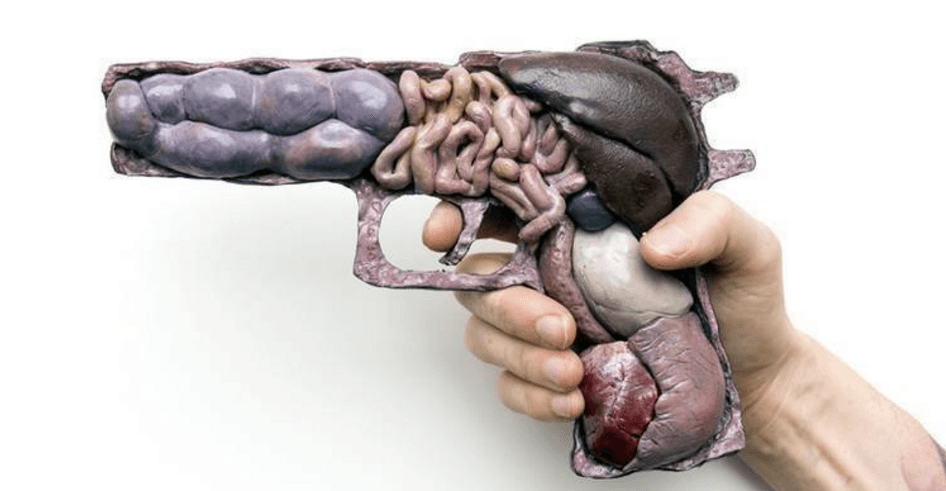”On the one hand I am extremely passionate about scientific inquiry and there are a lot of scientists I greatly admire, and yet I don’t know how to rectify the fact that many of them were involved with the creation of some the most horrific devices ever imagined.”
Noah Scalin is an American sculptor who focuses on humanizing the concept of war in modern society. His ‘Anatomy of War’ series raises questions about the victims of conflict (“on both sides of the gun”), and his ambivalent relationship with human invention. We caught up with Noah to talk about growing up surrounded by the threat of nuclear attacks, his activist upbringing, and the consequent shaping of his practice as an artist.
Your portfolio contains a collection of works titled ‘The Anatomy of War’. How did you come up with that theme?
Growing up in the 80’s I lived with a constant fear that a nuclear war could happen at any moment. This wasn’t a crazy thing to believe, since it was continually being reinforced in popular culture at the time.
The ‘Anatomy of War’ body of work comes on the heels of a series I did in 2014 called Manhattan Project, which featured images of scientists connected with the creation of the atomic bomb made from matches.
On the one hand I am extremely passionate about scientific inquiry and there are a lot of scientists I greatly admire, and yet I don’t know how to rectify the fact that many of them were involved with the creation of some the most horrific devices ever imagined.
After I completed that series I was thinking about violence post World War II and wondered what weapons were most commonly used in the wars since then. That line of thinking led to my working on the pieces that would eventually become ‘Anatomy of War’.
Tell us about your ‘Anatomy of War: AK-47 and Smith & Wesson’ pieces. What is the story behind them?
I loved the idea of transforming something cold and hard into something visceral. Making a gun into something that didn’t look tough or cool. Making it into something that spoke more about the human lives on both ends of the barrel.
It’s hard to talk about guns right now, they’re so polarizing here in the US. And while I’m a pacifist who’s never owned a gun, some of my very close friends and family are gun owners and enthusiasts. I wanted to find a way to open up a space for a discussion between people of varying viewpoints rather than just condemning one group or another.
What materials did you use to create them? Walk us through the process.
The Smith & Wesson was created entirely out of a polymer clay and painted with acrylics. It was finished with a gloss enamel to give it a more realistic appearance.
When it came time to make the AKs I realized that the press mould technique wasn’t going to work. I went through a bunch of experiments before deciding that 3-D printing was going to be the best way to go. I worked with Third Surface (http://www.thirdsurfacerva.com/) to develop the shells and then I coated the interior with a modeling compound before making the organs.
Can you also walk us through the process of creating ‘Anatomy of War: Bullets’?
For these pieces I had a friend of mine, who is a gun enthusiast, bring me to a local shooting range that he had a relationship with already. They were completely welcoming and enthusiastic about the whole process.
This was really only the third time I’d ever shot a gun, so my friend supervised and helped me the entire time. I was shooting from only a few inches away using a .22 and then he would help me by shooting the 9mm where I asked him to, since I had a lot less control over it. I can really see the appeal in target shooting, it’s fun to do.
But then I’d think about how remarkably little effort it was taking to squeeze the trigger and how I could easily have hurt myself or someone else by being just a little careless and it put things into perspective.
Who is Mikhail Kalashnikov and why did you choose to use him as the subject of both ‘Bullets’ and ‘Matches’?
Mikhail Kalashnikov created the design of the AK-47 while serving in the Russian army. In my research about him I discovered that he was really ambivalent about his invention. While never outright denouncing it he often made statements that showed his unease with its proliferation.
“I’m proud of my invention, but I’m sad that it is used by terrorists. I would prefer to have invented a machine that people could use and that would help farmers with their work – for example a lawnmower.”- Mikhail Kalashnikov.
He ultimately reached out to the leader of the Russian Orthodox Church seeking absolution for his contribution to the deaths of untold numbers of people, shortly before his death in 2013 at 94 years old. He wrote:
“The pain in my soul is unbearable. I keep asking myself the same unsolvable question: if my assault rifle took people’s lives, it means that I, Mikhail Kalashnikov, son of a farmer and Orthodox Christian, am responsible for people’s deaths.”
Much like the Manhattan Project scientists, I found myself fascinated by the idea of how this invention could have such a profound and long-lasting impact on both the world and its inventor.
What do you hope to affect within your viewers with your work?
I would love for this specific body of work to help shift the conversation about guns away from fears and reactionism, to a more thoughtful one about what kind of world we want to live in and how best to prioritize our needs and lives.
 To see more of Noah’s work, head to http://www.noahscalin.com/
To see more of Noah’s work, head to http://www.noahscalin.com/








